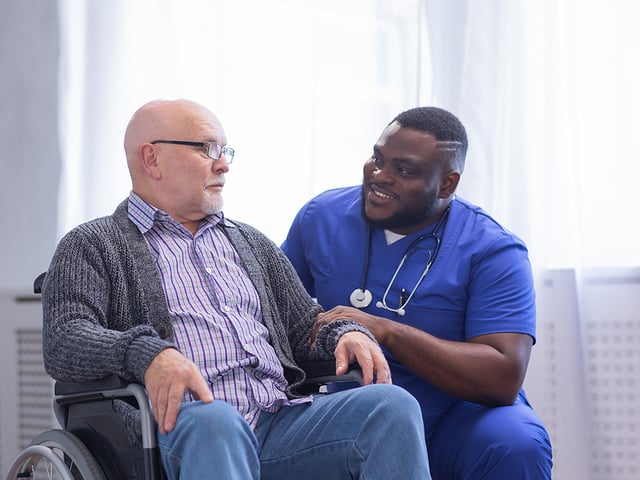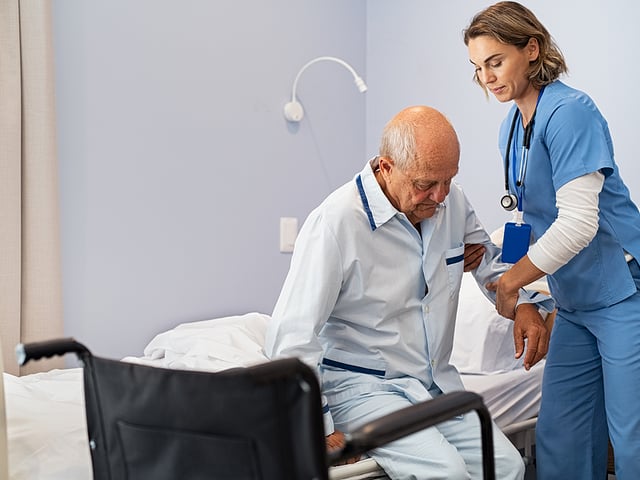
CNA Skills: Collecting Vital Signs and Measurements
As a CNA, you will assist the clinical team in both patient care and patient assessment. One of the most frequent and routine tasks is collecting and recording vital signs and measurements. You will likely be asked to perform one of these skills on your skills exam, but in the real world, you will probably perform most of these multiple times a day.
Measuring Height Using an Upright Scale
In the world of healthcare, routine check-ups and hospital admissions necessitate the precise measurement of a patient’s height. This seemingly simple task holds significant importance due to its vital role in calculating the patient’s Body Mass Index (BMI) , a crucial health indicator derived from the height and weight parameters.
The measurement of height, when done using an upright scale, calls for a careful and methodical approach. It’s crucial to ensure you’ve undertaken the Opening Procedure, setting the stage for the task at hand.
A major prerequisite for this process is the stability of the patient. Make certain that they are capable of standing unassisted, eliminating the risk of falls and injuries. As you guide the patient towards the scale, ensuring their safety is paramount. To this end, they should be wearing non-skid footwear. However, for the actual measurement, it is essential that shoes are removed to get an accurate reading of the patient’s actual height.
Hygiene is another factor that demands attention during this process. Placing a disposable paper towel on the scale serves as an effective hygiene measure, protecting both the patient and the equipment from potential contamination.
When ready, ask the patient to step onto the scale, maintaining a straight, upright posture. This position facilitates an accurate measurement of their height. Lower the height bar carefully until it lightly touches the top of the patient’s head. The patient’s height should then be recorded according to the scale’s specifications - this could be in feet and inches, just inches, or in centimeters.
Following the measurement, it’s crucial to ensure that the patient safely steps off the scale. Before they proceed to walk, confirm that they are once again wearing non-skid footwear to prevent any mishaps. With the process completed, the paper towel used can be disposed of responsibly, adhering to the protocol of maintaining a clean and safe environment.
The procedure then concludes with the Closing Procedure. This encapsulates the entire process, marking the successful completion of the task and ensuring that all necessary precautions and measures were duly observed.
Measuring Weight Using an Upright Scale
The measurement of a patient’s weight plays a vital role in healthcare, significantly impacting both medication dosages and the monitoring of a patient’s fluid status. By providing insights into the patient’s general health, weight contributes to the creation of individualized treatment plans. Accurately measuring the patient’s weight using an upright scale involves a series of steps that need to be undertaken with precision.
In preparation for weight measurement, the same steps used in the process of measuring a patient’s height are followed to assist the patient onto the scale. However, there are certain additional considerations before the patient steps onto the scale.
Firstly, ensure the scale is accurately calibrated to zero. The significance of this step cannot be overstated; it guarantees that the reading will be accurate, ensuring the correct determination of medication dosage and fluid balance.
Following this, you can guide the patient onto the scale. It’s imperative at this point that they stand still, maintaining a straight posture, to ensure the most precise weight measurement possible.
The measurement process involves moving the large weight on the scale in 50 lb increments. This is done until the scale’s indicator is approximately balanced. You can then finely adjust the balance using the smaller weight slider. Once the balance beam settles at equilibrium, the weight measurement can be read.
Following the measurement, record the patient’s weight meticulously, ensuring no errors. This step is important, as an incorrect recording could lead to inaccurate medication dosages or flawed assessments of the patient’s fluid status.
After ensuring the weight measurement has been accurately recorded, you should assist the patient off the scale, prioritizing their safety at all times. Hygiene should be maintained by disposing of the paper towel used on the scale responsibly, thus reducing the risk of any cross-contamination.
Lastly, complete the task by performing the Closing Procedure. This marks the end of the process and signifies that all necessary protocols have been followed.
Recording Radial Pulse
The radial pulse refers to the pulse that can be felt on the radial artery located on the underside of the wrist, on the same side as the thumb. This particular artery is most commonly used for pulse measurement due to its accessibility and proximity to the skin’s surface.
To start, ensure that you have performed the Opening Procedure, setting the stage for an accurate and comfortable measurement process.
The method of taking the pulse involves using your fingertips. Refrain from using your thumb for this purpose. The thumb, with its own distinct pulse, can inadvertently interfere with the accuracy of the reading. Instead, place your index and middle fingertips gently on the patient’s wrist, over the radial artery.
It’s crucial to apply just the right amount of pressure - too much pressure may occlude the artery and distort the pulse, while too little pressure may make it difficult to feel the pulse. Once you’ve found the pulse, you should maintain your finger placement and start counting.
For the pulse counting process, you’ll require a watch with a second hand or a digital watch with a seconds counter. Observe the watch and count the number of pulses felt for a full minute. This gives the most accurate representation of the patient’s heart rate. If you’re pressed for time, you can count for 30 seconds and multiply by two, although this method is slightly less accurate.
Following the counting, record the pulse rate immediately to avoid any forgetfulness or confusion that might lead to an incorrect record. This data is essential in evaluating the patient’s heart function and overall cardiovascular health. Upon completion of these steps, wrap up the procedure by performing the Closing Procedure.
Recording Respirations
Before initiating the procedure, execute the Opening Procedure. This is a vital aspect of patient care that helps establish a connection with the patient, enhancing their comfort level and building trust. Explain to the patient that you will be taking their vital signs, but don’t specify that you are going to measure their respiratory rate. This ensures that the patient maintains their normal breathing pattern, providing a more accurate reading of their baseline respiration rate.
To make the patient feel comfortable and to ensure the patient maintains their usual breathing rhythm, you might need to adopt a subtle approach. One common strategy is to ‘disguise’ the respiration count as a pulse check. This strategy works effectively because both pulse and respiration can be counted over the same time frame of one minute, and the physical positioning is similar.
Hold the patient’s wrist as if you are checking their pulse. While doing so, visually observe the rise and fall of the patient’s chest or abdomen. Each rise and fall counts as one complete breath. Be mindful to remain unobtrusive as possible in your observation to avoid alerting the patient to your actual intent, which could inadvertently affect their breathing pattern.
Count the number of breaths the patient takes over a full minute to ensure accuracy, as respiratory rates can vary from breath to breath. A shorter count may not give a true reflection of the patient’s regular breathing pattern.
Once you have taken the measurement, record the respiratory rate in the patient’s chart immediately to ensure the information is documented accurately. This data becomes a critical part of the patient’s health record, contributing to their ongoing health assessment and care plan.
Following the measurement and recording, perform the Closing Procedure. This includes communicating with the patient about the completion of the vital signs check, maintaining patient comfort, and ensuring a professional environment throughout.
Recording Blood Pressure
Prior to beginning, you need to ensure the cleanliness of your tools. Wipe the stethoscope earpieces, bell, and diaphragm with an alcohol wipe to ensure it’s hygienic and ready for use. Following this, conduct the Opening Procedure, which sets a positive, professional tone for the interaction and assures the patient of the upcoming procedure.
The patient’s comfort and positioning are key to an accurate blood pressure reading. The patient’s arm should be resting at heart level, in a relaxed and comfortable position. This positioning allows for the most accurate blood pressure measurement by ensuring the blood flow is at the same level as the heart.
The brachial artery, located on the inner aspect of the arm, is the optimal site for blood pressure measurement. The cuff should be wrapped snugly, about two inches above the antecubital fossa (the bend of the elbow), ensuring it’s directly over the bare skin and not over clothing or a hospital gown. This allows for direct contact and accurate pressure transmission.
Insert the cleaned earpieces of the stethoscope into your ears and place the diaphragm over the brachial artery. Begin inflating the cuff until the radial pulse is no longer palpable. This inflation occludes the artery and allows for measurement of the systolic and diastolic pressures.
Upon reaching the occlusion point, start to release air from the cuff at a steady rate of about 2-4 mmHg per second. Listen carefully for the first sound using the stethoscope - this indicates the systolic blood pressure, or the pressure exerted when the heart is contracting.
As you continue to release air, there will be a point when the sounds become muffled and then disappear. This silence indicates the diastolic pressure, the pressure in the arteries when the heart is at rest between beats.
As soon as the diastolic reading is obtained, quickly release the remaining air from the cuff for the patient’s comfort. Following this, remove the cuff carefully and document the blood pressure reading immediately. The systolic reading is written over the diastolic reading, with a slash separating the two.
Finally, execute the Closing Procedure, signaling the completion of the blood pressure recording process and maintaining professionalism throughout. This essential skill, when performed accurately and attentively, can significantly contribute to the understanding and management of a patient’s health status.
Get Ready To Excel as a CNA!
As you embark on your journey as a CNA, rest assured that you’ll play a pivotal role in patient care and assessment. From daily tasks such as gathering vital signs to other essential measurements, these routines form the core of your responsibilities. These skills not only equip you to excel in your exams but also prepare you for the realities of your day-to-day tasks in your profession.
The process of measuring height and weight with an upright scale, recording the radial pulse, counting respirations, and measuring blood pressure all form a crucial part of patient health assessments. A firm understanding and skilled application of these procedures are key to providing top-notch patient care.
Remember, each of these tasks, from height measurement for accurate BMI calculation to careful pulse monitoring, contributes to a broader understanding of patient health. Hygiene, precision, and patient comfort are paramount throughout these processes, as is careful recording of each measurement for accurate health records.
In conclusion, the acquisition of these skills not only prepares you for your CNA exam but also equips you with the tools necessary to excel in your professional duties. Utilize the resources available, like our CNA practice tests, study guides, and flashcards, to refine these skills further. As you step into the real world of healthcare, you’ll find these skills not only useful but also vital in your day-to-day tasks. Stay confident, stay prepared, and continue on your path to becoming an exceptional CNA.
Keep Reading

Certified Nursing Assistant Exam Blog
How Long Does it Take to Become a CNA?
As a profession on the frontline of healthcare, Certified Nursing Assis…

Certified Nursing Assistant Exam Blog
How to Do Well on the CNA Skills Test
Over 1.3 million nursing assistants work in our healthcare system today…

Certified Nursing Assistant Exam Blog
What Does a Nursing Assistant (CNA) Do?
Are you interested in exploring medical careers? The healthcare industr…